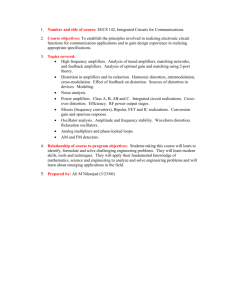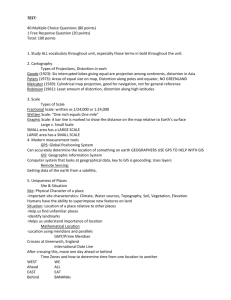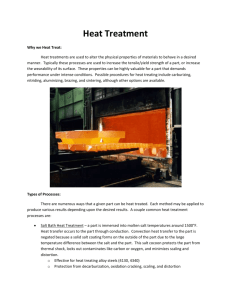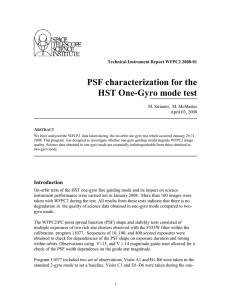Toward a Multi-Wavelength Geometric Distortion Solution for WFPC2.
advertisement
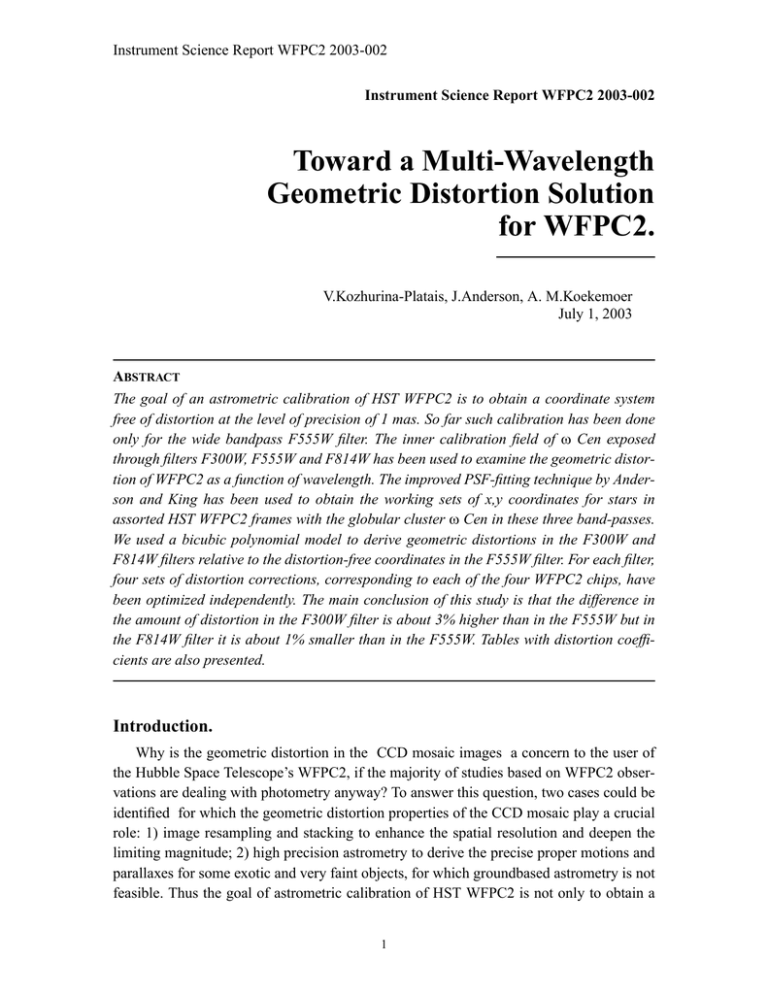
Instrument Science Report WFPC2 2003-002 Instrument Science Report WFPC2 2003-002 Toward a Multi-Wavelength Geometric Distortion Solution for WFPC2. V.Kozhurina-Platais, J.Anderson, A. M.Koekemoer July 1, 2003 ABSTRACT The goal of an astrometric calibration of HST WFPC2 is to obtain a coordinate system free of distortion at the level of precision of 1 mas. So far such calibration has been done only for the wide bandpass F555W filter. The inner calibration field of ω Cen exposed through filters F300W, F555W and F814W has been used to examine the geometric distortion of WFPC2 as a function of wavelength. The improved PSF-fitting technique by Anderson and King has been used to obtain the working sets of x,y coordinates for stars in assorted HST WFPC2 frames with the globular cluster ω Cen in these three band-passes. We used a bicubic polynomial model to derive geometric distortions in the F300W and F814W filters relative to the distortion-free coordinates in the F555W filter. For each filter, four sets of distortion corrections, corresponding to each of the four WFPC2 chips, have been optimized independently. The main conclusion of this study is that the difference in the amount of distortion in the F300W filter is about 3% higher than in the F555W but in the F814W filter it is about 1% smaller than in the F555W. Tables with distortion coefficients are also presented. Introduction. Why is the geometric distortion in the CCD mosaic images a concern to the user of the Hubble Space Telescope’s WFPC2, if the majority of studies based on WFPC2 observations are dealing with photometry anyway? To answer this question, two cases could be identified for which the geometric distortion properties of the CCD mosaic play a crucial role: 1) image resampling and stacking to enhance the spatial resolution and deepen the limiting magnitude; 2) high precision astrometry to derive the precise proper motions and parallaxes for some exotic and very faint objects, for which groundbased astrometry is not feasible. Thus the goal of astrometric calibration of HST WFPC2 is not only to obtain a 1 Instrument Science Report WFPC2 2003-002 world coordinate system (WCS) free of distortion down to the level of precision of 1 mas, but also to obtain a contiguous and seamless image over the FOV of the entire CCD mosaic. To achieve this goal, coordinates of individual CCD chips must be translated into the WCS and fluxes stacked up, employing point spread function fitting. If the knowledge of the PSF across the whole CCD mosaic frame, precise CCD mosaic metrology, and a distortion-free WCS are neglected, image re-sampling and stacking will produce an unwanted blurring of the objects of scientific interest. The geometric distortion of the CCD mosaic is a complicated issue, since each individual CCD chip in the mosaic is not only a separate detector but also is integrated with its own corrective optics and therefore consists of individual properties: slightly different quantum efficiency, charge transfer efficiency, noise properties, and different geometric distortion within individual CCD chips, as described by Platais et al. (2002), and by Anderson and King (2003) . In the case of WFPC2, apart from distortion within individual CCD chips, there is also the expectation of some amount of global distortion stemming from the HST aberrated primary mirror and secondary - the Optical Telescope Assembly (OTA) (see Casertano, S., in HST Data Handbook, 1997), which affects all four WFPC2 chips in the same fashion and could be represented by a single polynomial model. It is expected, however, that the contribution of the global distortion to the individual geometric chip solutions is at the level ~ 1mas. The geometric distortion of HST WFPC2 has received repeated attention in terms of astrometric calibrations, e.g. Gilmozzi et al.(1995), Trauger et al.(1995), Holtzman et al.(1995), Casertano and Wiggs (2001), Kozhurina-Platais et al.(2002), Anderson and King (2003). Gilmozzi et al.(1995) solved the geometric solution using third order Legendre polynomials for all four chips of WF/PC and WFPC2. Once the distortion correction was determined, the resulting residuals of the four chips, transformed into one meta-chip coordinate system, were fitted to find the offsets, rotation and scale for each of four chips. The distortion derived from WFPC2 images ranges from a tenth of a pixel in the center of each chip, up to 2-3 pixels at the edges of each chip. Some changes in plate scale were seen between the different filters for WFPC2. The amount of scale change is very similar to what was derived in this study. To calculate the geometric distortions of WFPC2, Holtzman et al. (1995) used the Gilmozzi formalism i.e. general cubic distortion representation given by a third order polynomial, under the assumption that the distortion is zero at pixel location (400,400), i.e. symmetrical around this point. The scale and orientation of the center of the PC were chosen to define the global corrected result of the articulated fold mirror (AFM) motion. The global solution was used to derive the relative scale of each chip for the chip center and relative rotations of each chip relative to the PC. The RMS of the fit was < 0.25 PC pixels, corresponding to ~ 10 mas, slightly larger than the accuracy of measurement in the WF cameras. The solved cubic distortion terms were very similar in all four cameras. 2 Instrument Science Report WFPC2 2003-002 Trauger et al. (1995) extended and superseded Holtzman’s geometric distortion solution by considering the wavelength dependence in the optical distortion, especially at FUV wavelengths. The WFPC2’s wavelength-dependent geometric distortions were computed by analysing the results of ray tracing, where the coefficients were represented as a quadratic interpolation function of the refractive index n of the MgF2 field-flattener lenses. The correction of geometric transformations provided by Trauger are accurate to within 0.1 pixel RMS (or 4 mas) over the field-of-view of the CCD. Casertano and Wiggs (2001) attempted to improve the geometric solution for WFPC2, using data which were specifically designed to provide a good sampling in all regions of the field-of-view, using the Holtzman formalism and global solution to derive the coefficients of the geometric distortion for the F555W filter. This geometric solution for WFPC2 showed small systematic residuals, especially in WF cameras. The recorded RMS of the residuals are 1.2 mas in the WF cameras and under 4 mas in the PC. Kozhurina-Platais et al. (2002) have expanded the analysis of the distortion for another two band-passes, F300W and F814W, employing the Holtzman formalism with Casertano’s modification. The derived geometric distortion solutions did not fully represent distortions in the F300W and F814W filters since the chosen data set of observations were not rotated with respect to each other to find the non-perpendicularity of coordinates axes - the skew parameter. However, the derived solution provided clues about the scale change from filter to filter and, within the uncertainties, confirmed the values of the previously found distortion coefficients. The early attempts to measure the amount of the geometric distortion provide fairly precise sets of distortion coefficients, although each of them failed to detect the skew term, which actually is responsible for a ~0.25 pix residual distortion (Anderson and King 2003). Using the inner calibration field of ω Centauri consisting of 80 exposures through F555W, Anderson and King (2003) derived a new, substantially improved, geometric solution for WFPC2. A large data set at various orientations and offsets allowed them to solve for the non-perpendicularity of the coordinate axes (skew terms), and achieve an accuracy for the geometric solution close to 0.01 pixels in WF cameras and 0.02 pixels in the PC. In this study we use the ’astrometric standard field’ (Anderson and King 2003) to calculate the amount of geometric distortion in the F300W and F814W filters. Thus we have expanded the analysis of geometric distortion of WFPC2 as a function of wavelength for another two filters, F814W and F300W, and also established the plate scale and skew parameters. Data Set and Reduction The first step in the analysis of the geometric distortion is to measure the position for each star in each chip of each exposure. It is a well known fact that the PSF of HST WFPC2 is under-sampled and variable over the CCD chips and because of that, the images 3 Instrument Science Report WFPC2 2003-002 may suffer from systematic errors, i.e. the position of a star depends on its location on the chip. While Casertano et al. (2001) were able to measure the position of stars in F555W with errors of 0.25 pixels, Kozhurina-Platais (2002) improved the measurement of position to 0.05, 0.06 and 0.08 pixels for the F555W, F814W, F300W filters respectively, using the analytical PSF fitting technique IRAF/PSF/ALLSTARS (Stetson 1987, Stetson et al, 1990). The accuracy of stellar positions for under-sampled images depends critically on deriving the highest precision PSF. Anderson and King (2000) developed a new concept of an ‘effective PSF’. Whereas most previous PSF models used an analytical function to approximate the instrumental PSF, which must be integrated over pixels to be compared with the image data. The approach of the effective-PSF can be summarized as follows: 1. it is completely empirical - no analytical function is approximated; 2. the effective PSF is derived from observed pixel values; 3. the effective PSF is fitted to the pixel values by simple evaluation and scaling without any integration. The spatial variation of the PSF was solved for nine fiducial PSFs placed at extreme points in the images so as to interpolate the locally appropriate PSF to any place on the chip. The spatially variable effective-PSF model approach has reduced the systematic error (the pixel-phase error) to the level of 0.002 pixel for all regions of the chip. Thus the random error in measurement for a typical star is 0.02 pixel in each coordinate. The WFPC2’s wavelength-dependent geometric distortions have been computed from a series of overlapping images of the globular cluster ω Cen, taken in three WFPC2 bandpasses - F300W, F555W and F814W -over a single five hour period in June 13, 1997. The exposures were 100 sec for F555W and F814W, and 160 sec for F300W. Each set of the F300W, F555W and F814W images consists of two central pointings at α=13h27m11s.8 and δ=-47o29’54."7 with a 0."25 shift and four outer pointing pairs with 35" offsets (with an offset of 0."25 in each pair), the orientation of each of the pointings were similar to one another and ranged from 244o.68 to 244o.71 , as shown schematically in Fig.1. 4 Instrument Science Report WFPC2 2003-002 Figure 1: The schematic illustration of the observation of ω Centauri taken June 13, 1997. Each set of the F300W, F555W and F814W images consists of two central pointings with a 0."25 shift and four outer pointing pairs with 35" shifts (with an offset of 0."25 in each pair). The orientation ranges from 244o.68 to 244o71. 5 Instrument Science Report WFPC2 2003-002 Thus, the position and instrumental magnitude of each star on each image was measured using the effective-PSF approach. If a star was identified in both F555W and F814W, we attempted to measure it also in the F300W filter. A linear transformation was performed to cross-identify stars in various frames of nearly the same pointing. The residuals after a linear transformation of distortion corrected coordinates in F555W and, for example, the F300W filter, using the Anderson and King (2003) coefficients, are shown in Fig. 2. It is obvious that, at least in the WF cameras, there is some unaccounted residual distortion, apparently arising from positions in F300W with a varying amplitude and phase from chip to chip. Figure 2: The residuals between the ’astrometric flat field’ (F555W positions corrected for geometric distortion) and star positions in the F300W filter, after applying only a linear transformation. As can be seen , there is varying amplitude - from 0.01 to 0.05 pixels and phase for each WFPC2 chip. The panels from top to bottom represent the WFPC2 camera chips: PC, WF2, WF3, WF4 . 6 Instrument Science Report WFPC2 2003-002 The Geometric Distortion Model. As mentioned by Anderson and King (2003), in order to solve for the distortion correction of HST images, it would be much easier to have prior knowledge of the positions of all stars in a distortion-free system. Then, the residuals between observed and distortion free relative positions of the stars would be the distortion. At the time of this writing the Anderson and King (2003) solution does provide such distortion free coordinates for the F555W filter at the precision level of 0.02 pixel. Thus, the geometric-distortion corrected positions in the F555W filter were chosen as an ’astrometric flat field’ at each of the nearly identical pointings for F814W and F300W. Then, the positions in the filters F300W and F814W were reduced into this astrometric flat field using a third-order polynomial model. In other words, the improved distortion coefficients are directly obtained as terms of a bicubic polynomial which transforms the distorted pixel coordinates x and y of F300W and F814W for each of the WFPC2 chips into geometrically corrected coordinates Xg ,Yg in the F555W filter. The transformation operates on a single 800 x 800 CCD image. However, the positions x,y have been normalized over the range (50:800) excluding the pyramid edges (Baggett, S. et al. 2002) and adopting the center of our solution at (425,425) with scale factor of 375. Thus, the positions x,y are normalized in the same way as by Anderson and King (2003), i.e. X=(x-425)/375 and Y=(y-425)/375. The final solution is represented as a third - order polynomial (Anderson and King 2003): Xg=a1 + a2X + a3Y + a4X2 + a5XY + a6Y2X + a7X3+ a8X2Y + a9XY2 + a10Y3 Yg=b1+ b2X + b3Y + b4X2 + b5XY + b6Y2X + b7X3 + b8X2Y + b9XY2 + b10Y3 (1) where the sets of coefficients a and b are obtained for each of the WFPC2 CCD chips by least squares. For each of the ten overlapping F300W/F555W and F814W/F555W pairs, and for each chip, independent solutions were calculated using the least squares minimization of the third-order polynomial. These ten sets of newly derived coefficients were each averaged and the standard deviation of the coefficients calculated. As illustrated by Fig. 3, after applying the newly derived bicubic-polynomial, the residuals are essentially flat . 7 Instrument Science Report WFPC2 2003-002 Figure 3: The residuals between the ’astrometric flat field’ (after correcting F555W positions for geometric distortion using a standard Anderson-King solution) and star positions in the F300W filter, applying the bicubic polynomial transformation. As can be seen, the residuals no longer have systematics as a function of coordinates. The panels from top to bottom represent the WFPC2 camera chips: PC, WF2, WF3, WF4. The early geometric distortion solutions as mentioned above failed to find the non-perpendicularity of coordinates axes - the skew parameter - because; 1. the data sets which were used all had the same orientation, i.e. the shifts between of exposures are parallel; 2. external information about the size of the absolute offsets was used to solve for the linear terms including the scale; 8 Instrument Science Report WFPC2 2003-002 3. the meta-chip nature of the early geometric distortion solution tends to propagate errors from the PC (which is most affected by skew distortion) into the solution for the WF cameras. Thus, the principal difference from the earlier distortion solutions is to establish the skew terms. The skew term was estimated directly, using an astrometric flat field in the F555W filter which was possible owing to the large variety of HST roll angles. The derived values of skew terms (the b2 term in the third-order polynomial equation) in the filters F300W and F814W are provided in Table s1 and 2, which are in good agreement with the Anderson and King solution for F555W within the error of the skew terms. WFPC2 Geometric Distortion for F300W and F814W Holtzman et al. (1995) point out that there should be a small but perceptible difference in the amount of expected distortion as a function of wavelength. Our distortion solutions in the filters F300W and F814W (Tables 1,2) do show differences with respect to the Anderson and King distortion correction in filter F555W. Each set of our mean distortion coefficients is based on 10 individual geometric solutions, derived from a least-squares minimization. The required corrections to account for the cubic distortion are given in Tables 1 and 2 (coefficients a4-a10 and b2-b10) . In Fig. 4 we present the difference in the distortion correction between the filters F555W and F300W. They clearly indicate a larger amount of distortion in F300W, especially at the corners of chips. An average increase of distortion in the F300W filter is ~3% or 0.18 PC pixels and 0.25 WF camera pixels. Another way to look at the distortion solution in F555W and F300W is to plot the differences in the coefficients themselves. They show the contribution of each term in pixels to the total distortion. The differences between the actual coefficients (Fig. 5) indicate large errors in the PC coefficients and nearly zero differences as opposed to small errors and distinctive behavior of the WF camera coefficient differences (e.g., compare a7,a8,a9). Larger errors in the PC distortion coefficients can be explained by the smaller number of stars and poorer centering precision in the filter F300W. 9 Table 1. The bicubic-polynomial terms for the F300W filter. aPC σ aWF2 σ aWF3 σ aWF4 σ bPC σ bWF2 σ bWF3 σ bWF4 σ 0.374 0.047 0.149 0.010 -0.142 0.014 -0.072 0.012 0.267 0.021 -0.164 0.014 -0.113 0.011 0.174 0.014 2 374.690 0.091 374.742 0.009 374.745 0.009 374.738 0.015 0.480 0.069 0.042 0.010 -0.028 0.008 0.048 0.006 3 0.055 0.032 0.001 0.009 0.006 0.008 -0.027 0.009 374.576 0.101 374.673 0.010 374.706 0.013 374.773 0.012 4 -0.547 0.035 -0.687 0.009 -0.363 0.005 -0.469 0.007 -0.298 0.113 -0.043 0.006 -0.019 0.005 -0.078 0.005 5 -0.255 0.035 -0.394 0.008 -0.299 0.007 -0.386 0.010 -0.265 0.051 -0.592 0.011 -0.419 0.005 -0.489 0.006 6 -0.235 0.078 -0.098 0.007 0.015 0.008 -0.079 0.005 -0.479 0.052 -0.453 0.018 -0.335 0.006 -0.386 0.008 7 -1.937 0.139 -1.837 0.019 -1.838 0.011 -1.874 0.022 -0.079 0.126 0.006 0.015 0.007 0.008 -0.028 0.008 8 0.003 0.067 0.034 0.016 0.003 0.013 0.054 0.012 -1.913 0.113 -1.877 0.024 -1.891 0.014 -1.950 0.014 9 -1.909 0.056 -1.869 0.010 -1.875 0.015 -1.936 0.009 -0.021 0.083 0.040 0.016 0.016 0.008 0.049 0.018 10 -0.039 0.064 0.001 0.007 0.021 0.012 -0.011 0.017 -1.863 0.148 -1.773 0.018 -1.846 0.016 -1.852 0.014 Table 2. The bicubic-polynomial terms for the F814 filter. 10 σ aWF2 0.009 0.075 0.009 0.081 0.003 0.046 0.006 0.048 0.007 0.075 0.004 0.055 0.008 -0.015 0.006 2 375.159 0.017 375.164 0.007 375.122 0.004 375.150 0.004 0.428 0.016 0.049 0.004 -0.037 0.004 0.066 0.004 3 0.002 0.014 -0.009 0.004 -0.011 0.002 -0.010 0.003 375.189 0.018 375.128 0.003 375.124 0.007 375.205 0.004 4 -0.526 0.009 -0.636 0.005 -0.344 0.002 -0.494 0.003 -0.281 0.005 -0.032 0.003 -0.018 0.002 -0.055 0.002 5 -0.264 0.008 -0.407 0.003 -0.365 0.004 -0.404 0.003 -0.305 0.008 -0.566 0.003 -0.401 0.003 -0.485 0.002 6 -0.253 0.009 -0.092 0.003 0.009 0.002 -0.059 0.002 -0.465 0.007 -0.439 0.004 -0.371 0.002 -0.408 0.003 7 -1.891 0.019 -1.769 0.005 -1.805 0.006 -1.832 0.004 -0.011 0.015 0.003 0.006 0.003 0.006 -0.013 0.003 8 0.005 0.013 0.027 0.004 0.005 0.005 0.017 0.005 -1.912 0.017 -1.809 0.005 -1.834 0.005 -1.858 0.004 9 -1.895 0.013 -1.806 0.004 -1.822 0.005 -1.853 0.005 0.014 0.017 0.017 0.005 0.009 0.003 0.029 0.006 10 0.004 0.016 0.016 0.004 0.018 0.004 0.000 0.003 -1.917 0.018 -1.735 0.007 -1.799 0.005 -1.837 0.006 aPC 1 -0.029 σ aWF3 σ aWF4 σ bPC σ bWF2 σ bWF3 σ bWF4 σ Instrument Science Report WFPC2 2003-002 1 Instrument Science Report WFPC2 2003-002 Figure 4: Differences in the distortion correction in the sense "F555W-F300W". The size of the longest arrows are 0.18 pixel for the PC (in PC pixels) and ~ 0.25 pixel for WF cameras (in WF pixels). The panel corresponds to PC -upper right; WF2 - upper left; WF3 lower left; and WF4 - lower right. The size of the residuals are scaled by a factor of 300. 11 Instrument Science Report WFPC2 2003-002 Figure 5: Direct differences between the coefficients of the geometric distortion polynomial for F300W in each of the WFPC2 chips in the sense "F555W-F300W". The difference appears to be negligible except for the PC, which can be explained by larger random errors due to the smaller number of stars observed through the PC camera. From top to bottom are PC,WF2,WF3,WF4 respectively. On the other hand, the cubic distortion is essentially identical in the F555W and F814W filters. This is illustrated by Fig. 6 which shows the differences in cubic distortion in the sense F555W-F814W. The longest vector is only 0.04 PC pixels or 2 mas and 0.05 WF pixels for the WF cameras, which is comparable with the image centroid precision. 12 Instrument Science Report WFPC2 2003-002 Figure 6: Differences in the distortion correction in the sense "F555W-F814W". The small amount of these differences along with a fairly random pattern changing from chip to chip indicate that the differences are very small, if any. The size of the longest arrow is 0.04 PC pixels for the PC, and ~0.05 pixels for the WF cameras. The size of the residuals are scaled by a factor of 300. The panels are the same as shown in Figure 4. 13 Instrument Science Report WFPC2 2003-002 Practical Application of the Distortion Coefficients. The application of the derived distortion coefficients is straight forward. To correct for geometric distortion of the measured raw coordinates x and y on a chip, the equation (1) should be used, employing the coefficients from Table 1 or Table 2. The measured raw coordinates should be normalized as X=(x-425 )/375 and Y=(y-425)/375. The corrected coordinates Xg, Yg are nominally in the F555W system which should be shifted back to the natural system of the detector, with its proper orientation and scale, specifically, X= Xg- 425 and Y=Yg- 425. The constant terms a1 and b1 are random offsets (or zeropoints) between any two frames and can be ignored. The linear coefffcients a2 and b3 represent the plate scale. The plate scale variation with filter has been discussed by Trauger et al. (1995) using calculations based on ray tracing through the optics of a model (not actual) camera. Here we present the plate scale (relative to F555W) as derived from our solution for F300W and F814W: Filter PC WF2 WF3 WF4 Mean F300W 0.99917 0.99931 0.99932 0.99930 0.99928 F814W 1.00042 1.00044 1.00033 1.00040 1.00040 The mean scale factor is in good agreement with predictions by Trauger et al. (1995). For the F300W and F814W filters the predictions are 0.99805 and 1.00025, respectively. The findings by Anderson and King (2003) from a much larger observational data set provide the plate scale - 0.99953 and 1.00036 for the F300W and F814W filters, respectively. A linear solution of the post-corrected positions in F300W-F555W and F814WF555W produced RMS values of 0.04 and 0.02 pixels for the F300W and F814W filters respectively. Conclusions. The precision of the geometric distortion solution for the WFPC2 cameras is dependent on 1) the centering technique in measuring star positions and 2) how the solution is performed. Solving the geometric distortion for each WFPC2 chip independently rather than deriving a meta-chip solution excludes the error propagation from one chip to the solution for another chip. The improved cubic distortion for F555W by Anderson and King (2003) and the newly derived cubic distortion for F814W and F300W have shown a clear correlation in the amount of geometric distortion as a function of wavelength. The 14 Instrument Science Report WFPC2 2003-002 amount of distortion in the F300W filter is about 3% higher than in F555W, but distortion in the F814W filter is about 1% smaller than in F555W. Therefore, for practical purposes it is safe to adopt the same distortion coefficients for both F555W and F814W, but not for the F300W filter. We also were able to establish the scale plate and skew parameter (nonperpendicularity of X and Y axes) for the F300W and F814W filters which are in good agreement with previous findings by Trauger et al. (1995) and by Anderson and King (2003). Recommendations. The expanded analysis of geometric distortion of WFPC2 as a function of wavelength for two filters, F814 and F300W, indicates the importance of astrometric calibration at wavelengths shorter than about 400 nanometers. It is expected that the amount of distortion in the FUV F255W filter with respect to F555W will be higher by a factor of 5% but this must be established from observations which are proposed for Cycle 12 . The planned cubic distortion measurements in F255W will allow us to linearly interpolate the cubic distortion from the near infrared wide bandpass F814W filter through the UV filters. The derived geometric distortion cooefficients can then used for: 1) stacking of images (e.g. with dithered offsets) using STSDAS/DRIZZLE; 2) as a starting point in calibrating the ACS astrometric properties; 3) general users of the archival WFPC2 observations, in particular, proper motion work. Acknowledgements. We are grateful to B.Whitmore and S. Casertano for support and interest in this study. V.K.-P. thanks Ronald Gilliand and Imants Platais for helpful comments and suggestions at various stages of this projects. V.K.-P. is indebted to Susan Rose , Megan Sosey and Inge Heyer for help with Frame Maker. References Anderson, J., King, I., 2002, PASP, 112, 1360 Anderson, J., King, I., 2003, PASP, 115, 113 Baggett, S., McMaster, M., et al. 2002, in HST WFPC2 Data Handbook, v.4.0, ed. B.Mobaster, (Baltimore, STScI). Casertano, S., et al., 1997, WFPC2 Instrument Overview, in HST Data Handbook, 24-1, (Baltimore, STScI) 15 Instrument Science Report WFPC2 2003-002 Casertano, S., Wiggs, M., 2001, in WFPC2 Instrument Science Report, 2001-10, (Baltimore, STScI) Holtzman, J., Hester, J.J., Casertano, S., Trauger, et.al. 1995, PASP, 107, 156 Gilmozzi, R., Ewald, S., Kinney, E., 1995, in WFPC2 Instrument Science Report, 9502, (Baltimore, STScI) Kozhurina-Platais, V., Casertano, S., Koekemoer, A., 2002, in HST Calibration Workshop, (Baltimore, STScI), ed. Arribas, S., Koekemoer, A., Whitmore, B. Platais, I., Kozhurina-Platais, V., Girard, T., et al. 2002, AJ, 124, 601-611 Stetson, P.B. 1987, PASP, 99,191 Stetson, P.B., Davis, L.E., Crabtree, D.R. 1990, in ASP Conf. Ser. 8, CCDs in Astronomy, ed. G.H. Jacoby, 289 Trauger, T.T., Vaughan, A.H., Evans, R.W., Moddy, D.D., 1995, in Calibrating Hubble Space Telescope: Post Servicing Mission. (Baltimore, STScI), ed.Koratkar, A., Leitherer, C. 16


